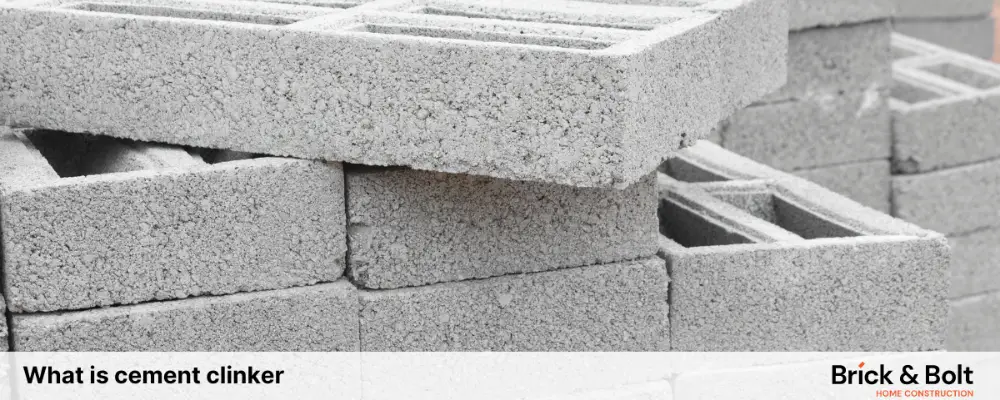Cement clinker is a solid material collected during the production of Portland cement. These lumps or nodules act as a binder in many cement products. It is a cornerstone of modern construction demanded by people worldwide.
If you want to know cement clinker in detail, then read this article. We’ll discuss cement clinker, its types, uses, and composition.
What is Cement Clinker?
Cement clinker is an intermediary product produced during the manufacturing of cement. It looks solid and dark grey in colour. It is collected as lumps or nodules appear in 3mm to 25mm in diameter. The cement clinker is produced by heating clay and limestone together at a temperature range of 1400 to 1500 degrees Celsius. When ground finely and mixed with gypsum, cement is manufactured.
Cement Clinker Types
Cement clinker is categorised into 5 different types and is explained below:
Sulfate Resistant Clinker
Sulfate resistant clinker contains 1% free calcium oxide, 2% tricalcium aluminate, 5% belite, 16% tetracalcium aluminoferrite, and 76% alite. The primary purpose of using this type of clinker is sulfate resistant capacity. However, its production has drastically decreased in recent times, as this functionality is easily obtained by granulated furnace slag during cement production.
Low Heat Clinker
The composition of this clinker is 29% alite, 2% tricalcium aluminate, 54% belite, and 15% tetracalcium aluminoferrite. It has very little amount of free lime. This type of clinker is no longer under production. Because the same low heat properties are being taken from the ordinary clinker and granulated blast furnace slag.
White Clinker
The white clinker is composed of 7% tricalcium aluminate, 76% alite, 2% free lime, 15% belite, and no tetracalcium aluminoferrite. These compositions may vary according to the requirements. White clinker is a primary material to produce white cement, which can elevate the overall space look in construction. It is primarily used in pre-cast concrete applications.
Low-alkali Clinker
The alkali content in the clinker can be achieved in two different ways, such as:
Replacing the source of raw-mix alumina with another component. In this way, you will receive a more expensive product from a distant source.
Another way is to install an alkali bleed, which involves removing high-temperature gases. The primary drawback of this method of wastage of heat.
Belite Calciumsulfoaluminate Ternesite (BCT)
These days, cement manufacturers are also emerging to take part in environmental responsibility. BCT is one type of green clinker that has 30% less carbon dioxide emissions than other types. Its manufacturing process is energy-efficient and consumes around 15% less electricity.
Uses of Cement Clinker
The primary purpose of clinker is to produce cement. It is a hard nodular substance and is essential to store in a dry condition for several months. Cement manufacturers around the world demand clinker for their cement plants where the raw materials are unavailable.
Clinker is used as a binder in cement products by combining it with some additives and crushed into a fine powder. Based on the desired properties of cement, the materials are adjusted. Meanwhile, the constant core substance is “gypsum,” which helps avoid immediate setting of the tricalcium aluminate.
Beyond regulating the setting time, it also improves the compressive strength of the cement. The most common additives used in the clinker are ethylene glycol, oleic acid, Triethanolamine, and dodecyl-benzene sulphonate. These ingredients with clinker produce other types of cement, such as
- Pozzolana cement
- Ground granulated blast furnace slag cement
- Silica fume cement
- Composite cement
Composition of Cement Clinker
The four major components of clinker are as follows:
Alite (Ca₃SiO₅)
Alite approximately contains tricalcium silicate, which is typically about 65% of the total composition. This is the abundant material responsible for the rapid hardening of cement.
Belite (Ca₂SiO₄)
Clinker contains almost 15% of dicalcium silicate of the total amount, which contributes to enhanced durability and strength of the cement.
Aluminate (Ca₃Al₂O₆)
This mineral is about 7% in the total composition of clinker, which helps for rapid setting. When this component reacts with sulfate, it may lead to expansion and cracking.
Ferrite (Ca₄Al₂Fe₂O₈)
Clinker contains approximately 8% of tetracalcium aluminoferrite, which includes iron, calcium, and aluminum. It plays a crucial role in the heat of hydration and controlling the setting time of cement.
General Percentage of Ingredients in Clinker
Apart from major components, clinker also contains some other substances in smaller amounts and are listed in the table:
| Ingredients | Percentage |
| Iron Oxide | 0.5 to 6% |
| Alkaline | Nil to 1% |
| Lime | 60 to 65% |
| Sulfur Trioxide | 1 to 3% |
| Magnesia | 1 to 3% |
| Silica | 17 to 25% |
| Calcium Sulfate | 0.1 to 0.5% |
| Alumina | 3 to 8% |
Final Thoughts
Clinker is a fundamental material in cement production, which is a mix of minerals and limestone. Its properties can be tailored according to the desired requirements. This article includes complete information about clinker, its types, properties, uses, and composition. It will be useful when manufacturing the Portland cement for the construction industry.
FAQs
Ordinary Portland cement contains a maximum of 95% clinker (the other 5% is gypsum). It means that for every 100 kilograms of cement, approximately 90 to 95 kilograms of clinker are required.
Yes, the decarbonized cement has 0% clinker that aims to reduce carbon footprint in the environment. Though it is not eliminated completely, the usage is drastically reduced for arresting the amount of carbon emission during the manufacturing process.
The alternative materials used in the cement production instead of clinker are such as broken glass, volcanic ash, ground limestone, and metakaolin. The primary reason to go with these alternatives is reducing the emission of carbon footprint.

